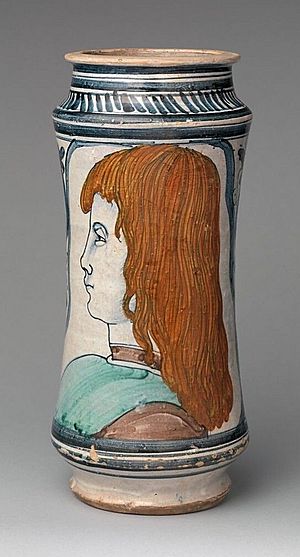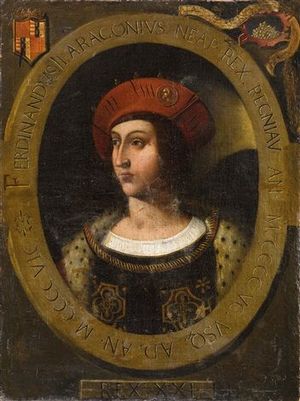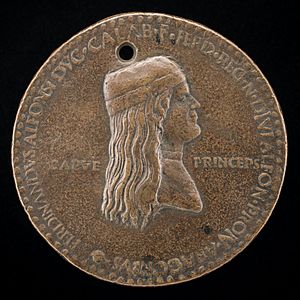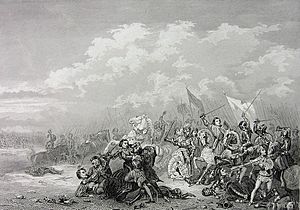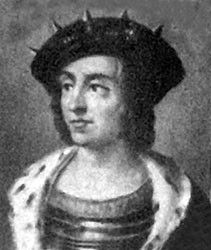Ferdinand II of Naples facts for kids
Quick facts for kids Ferdinand II |
|
|---|---|
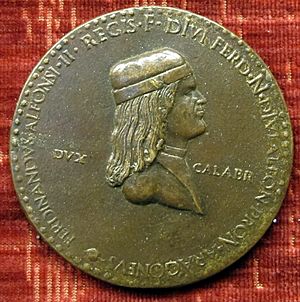
Medal of Ferdinand as Duke of Calabria by Adriano Fiorentino
|
|
| King of Naples | |
| Reign | 23 January 1495 – 7 September 1496 |
| Predecessor | Alfonso II |
| Successor | Frederick |
| Born | 26 June 1467 Naples, Kingdom of Naples |
| Died | 7 September 1496 (aged 29) Somma Vesuviana, Kingdom of Naples |
| Burial | San Domenico Maggiore |
| Spouse | Joanna of Naples |
| House | House of Trastámara |
| Father | Alfonso II of Naples |
| Mother | Ippolita Maria Sforza |
| Religion | Roman Catholicism |
Ferdinand II (also known as Ferdinando or Ferrante; born June 26, 1467 – died September 7, 1496) was the King of Naples for a short time, from 1495 to 1496. He was the son of Alfonso II of Naples and the grandson of Ferrante I of Naples.
In 1495, during the start of the Italian Wars, a French army led by Charles VIII threatened Naples. Ferdinand's father, Alfonso, gave up his throne to Ferdinand. But Ferdinand couldn't defend the city well. He fled with a small group of people to the island of Ischia. Charles VIII quickly took over Naples. He left some soldiers there and took the rest of his army back home.
By May 1495, Ferdinand returned with new troops and help from his allies in Aragon. With the help of the Spanish general Gonzalo Fernández de Córdoba, he forced the French soldiers out of the entire kingdom. Ferdinand died soon after, on September 7, 1496. His uncle, Frederick, became the next king.
Contents
Biography
Early Life and Family
Ferdinand II was born on June 26, 1467, in Castel Capuano, a palace in Naples. His grandfather, King Ferrante, had given this palace to Ferdinand's parents, Alfonso and Ippolita Maria Sforza, as a wedding gift. When Ferdinand was born, his father was away fighting in a war. But everyone was very happy because the kingdom had its rightful heir.
He was baptized on July 5 and was named Ferdinando, after his grandfather. He was also named Vincenzo, because his mother was devoted to Saint Vincenzo Ferreri. His mother's letters from that time describe him as a healthy, beautiful, but sometimes difficult baby. She wrote that he was "beautiful as a pearl" but "pleasant with every person except with me."
Growing Up and Learning to Fight
Ferdinand had wise teachers and advisors, including Aulus Janus Parrasius, Gabriele Altilio, and Chariteo. They stayed loyal to him even when he was a teenager and started learning about war.
When he was only fourteen, Ferdinand showed his skills in battle. His grandfather, King Ferrante, sent him to lead a military group in Abruzzo. His job was to protect the coasts from attacks by the Venetian fleet. This happened during the Salt War (1482-1484), when Ferrante had to help his son-in-law.
In the years that followed, Ferdinand continued to defend the kingdom. He fought against rebellious nobles during the second baronial revolt (1485-1486). This revolt caused great trouble for King Ferrante. But even bigger challenges awaited young Ferdinand when Charles VIII of France invaded.
One story tells of an accident when Ferdinand was about twenty years old. He asked for a strong horse, but the horse fell on him. People thought he was dead. He stayed in a coma for 13 days. His mother, Ippolita, prayed constantly for him. It was believed her prayers helped him recover. As a thank you, his father, Alfonso, had a silver image of Ferdinand made and gave it to a church.
Facing the French Invasion
In 1491, Ferdinand's younger brother Pietro died. This meant Ferdinand became the last hope for Naples and his aging grandfather, King Ferrante. Ferrante died on January 25, 1494. Alfonso II then became King of Naples. He immediately declared war on Ludovico il Moro. Alfonso wanted to help his daughter Isabella, whose husband's duchy had been taken by Ludovico.
Ludovico responded by inviting the French king, Charles VIII, to invade Italy. Charles VIII believed he had a right to the Kingdom of Naples.
As the main commander of the Neapolitan army, Ferdinand always acted honorably. Even though he was very young, he kept his soldiers in order. In October 1494, he was fighting the French in Romagna. The French tried to trap him at the city of Mordano. Ferdinand, with fewer men, decided not to fight directly. He listened to his generals and did not respond to calls for help from Caterina Sforza, a local countess.
Caterina became angry and switched sides to the French. Ferdinand had to leave with his men. Even though they were now enemies, and his army was short on food, Ferdinand always acted fairly. A writer from that time, Leone Cobelli, noted that Ferdinand never allowed his men to damage the lands or vineyards. He made sure his soldiers paid well for supplies.
Ferdinand was always eager to fight the French. In September 1494, he openly challenged them to battle. He even sent a messenger to the French captain, asking if he wanted to "break some spears" (meaning, fight). The French accepted one challenge, but a different captain stopped the fight. Ferdinand was disappointed and had to settle for smaller skirmishes.
The French Take Naples
An attempt to stop the French fleet carrying heavy cannons failed. After leaving Romagna, Ferdinand went to Rome. He urged Pope Alexander VI to stay strong and not abandon his father. But the Pope eventually gave in to the French. He offered Ferdinand a safe passage back to Naples. Ferdinand, being proud, refused this offer. On the last day of the year, he left Rome through one gate just as King Charles VIII entered with his army through another.
As the enemy troops got closer, Alfonso II decided to give up his throne to Ferdinand. Alfonso then became a monk in Sicily. Unlike his father, who was feared, Ferdinand was loved by the people of Naples. He was known as a "human and kind king." He immediately showed his good nature. Despite the kingdom's money problems, he returned lands that his father had unfairly taken. He also freed people who had been wrongly imprisoned. Ferdinand tried to fix all the wrongs done by his father and grandfather.
Ferdinand even challenged King Charles VIII to a duel to decide who should own the kingdom. But the French king knew Ferdinand was skilled and refused to fight him.
A real betrayal happened against Ferdinand. Cities began to surrender to the French. Commanders and generals secretly plotted with the enemy, helping them advance. When Ferdinand returned to Naples, he was very upset. He felt that luck was against him and he was losing the kingdom "without breaking a spear." When he heard people were looting his stables, he rushed there with a few men. He angrily scolded the looters, wounded some, and got back some horses.
Realizing the situation was hopeless, Ferdinand decided to leave Naples to find help. Before sailing to Ischia with his family, he gathered the people. He promised to return within 15 days. If he didn't, they would be free from their oath of loyalty to him.
He left the new Castel to Alfonso II d'Avalos with 4,000 Swiss soldiers. He then sailed to Ischia with 14 ships.
A famous betrayal happened at the fortress of Ischia. The castle's commander, Justo della Candida, barred the doors to the royal family. Ferdinand tricked Justo into letting him inside with just one man. Once inside, Ferdinand pulled out a dagger. He attacked Justo with such force that he took control of the castle and its soldiers.
Charles VIII in Naples and Ferdinand's Return
The French entered Naples on February 22, 1495. Charles VIII made Castel Capuano his home. Charles offered Ferdinand large lands in France if he gave up his claim to Naples. But Ferdinand's uncle, Frederick, told Charles that Ferdinand would never accept. He said Ferdinand was determined to "live and die as a king."
Charles had many supporters among the nobles in Naples. But he didn't use this to his advantage. He put French officials in charge of everything. This weakness gave other Italian states time to unite against him. It also gave Ferdinand time to rebuild his army.
In May 1495, a naval defeat against the Genoese fleet weakened Charles's army. He realized he needed to leave Naples and return home. He managed to get back to France, even after a defeat in the Battle of Fornovo.
Reconquering the Kingdom
Meanwhile, Ferdinand went from Ischia to Messina. There, he met his cousin, Ferdinand II of Aragon, King of Sicily and Spain. His cousin offered to help him take back the Kingdom of Naples. The Spanish general Gonzalo Fernández de Córdoba arrived with a small army. He was chosen because he was a favorite of Queen Isabella and a skilled soldier.
De Córdoba arrived in Messina on May 24, 1495. Ferdinand was very anxious but rejoiced when he saw the Spanish general. De Córdoba went to Calabria, where Ferdinand had already gone with his army. Ferdinand had already taken back the city of Reggio. De Córdoba arrived two days later. Ferdinand ordered his troops to attack the French who were in Calabria.
Ferdinand led his army out of Seminara on June 28. The fighting started well for Ferdinand's side. But the local Calabrian soldiers panicked and ran away. Even though Ferdinand tried to stop them, the French soldiers attacked the retreating Calabrians.
The situation became very difficult for Ferdinand's forces. The French commander, Monsignor of Aubigny, gathered more French soldiers. He challenged Ferdinand. Although the Spanish general tried to avoid a big battle, he agreed to satisfy Ferdinand. During the battle, King Ferdinand was easily recognized by his fancy clothes. He would have been in danger if John of Capua had not protected him. On the general's advice, Ferdinand returned to Reggio.
Despite the French victory in this battle, Ferdinand was soon able to retake Naples. This was thanks to the loyalty of the people. De Córdoba used clever tactics, avoiding direct fights with the strong Swiss soldiers. He slowly took back the rest of Calabria. Many French soldiers left because they weren't paid. The remaining French forces were trapped and forced to surrender. By July 7, Ferdinand had defeated the last French groups. He returned to Naples, where the people cheered for him, throwing flowers and embracing him.
Death and Succession
Ferdinand married his aunt, Giovanna. She was his father's half-sister. At the time of their marriage, Ferdinand was 29 and Giovanna was 18. The wedding took place in Somma Vesuviana. Ferdinand crowned his wife as queen there.
Ferdinand, who was already showing signs of malaria, made a will. He named his paternal uncle, Frederick, as the heir to the kingdom. Ferdinand died on October 7, 1496, at Castel Capuano.
Since Ferdinand had no direct children, his uncle Frederick inherited the crown. Frederick became King Frederick I of Naples. He was the last Aragonese king of Naples. After him, the kingdom was taken by the French.
Appearance and Personality
From a young age, Ferdinand learned both physical and intellectual skills. People who lived at the same time as him described him as agile and well-built. He was very good at jumping, running, vaulting, and riding horses. He also excelled in tournaments and competitions, often winning first place. Despite his skills, he was modest. He didn't get too excited by good times or too sad by bad times. He always had a cheerful face and thanked everyone.
He was brave, had royal manners, was loving, generous, and forgiving. One writer called him a "prince of high spirit and gifted with all those graces that nature and chance can give." Another said he was "vigorous, kind, meek, virtuous, and truly worthy of that Realm."
Physically, he was a handsome young man. He was strong, with bright eyes, a high head, a wide chest, and a muscular body. He was known to hold his head high. He also knew he was good-looking and sometimes wore simple clothes to show off his physique.
Ferdinand was also educated in literature. He had teachers like Gabriele Altilio and Aulo Giano Parrasio. He enjoyed writing poems in his free time. He once wrote a poem to a subject who was surprised by his departure from Naples, likely during the difficult French invasion: "Who is content with my departure, who rejoices, and laughs at who they like, who complains and who complains, who is afflicted by it and who despairs. Who pulls me in this trouble and who pushes me away, who is sorry and who is sorry. My wretched soul that torments itself in this fire it consumes itself and is silent."
In Popular Culture
- The character Ferdinand in William Shakespeare's play The Tempest is based on the historical figure of Ferdinand.
- In the 2011-2013 Canadian television series The Borgias, Ferdinand is played by Swedish actor Matias Varela. However, the character in the series is very different from the real historical Ferdinand.
Honours
| Knight of the Order of the Ermine | |
| — |
See also
 In Spanish: Fernando II de Nápoles para niños
In Spanish: Fernando II de Nápoles para niños
- Italian Wars
- History of Naples
- List of monarchs of Naples


